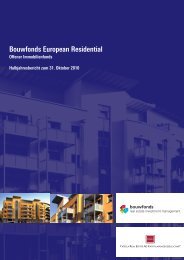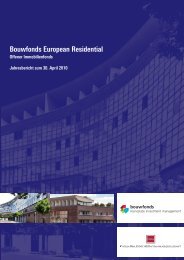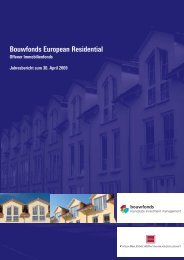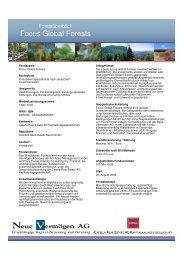Bouwfonds European Residential - Catella Real Estate AG
Bouwfonds European Residential - Catella Real Estate AG
Bouwfonds European Residential - Catella Real Estate AG
You also want an ePaper? Increase the reach of your titles
YUMPU automatically turns print PDFs into web optimized ePapers that Google loves.
In terms of product strategy, the Fund invests in apartments<br />
(80%-90%) and in niche markets such as senior citizens’<br />
apartments, serviced apartments and student accommodation<br />
(10%-20%). In order to offer investors additional yield<br />
potential, the Fund permits privatisations, although these are<br />
restricted to 20%. Investments in development projects of up<br />
to 20% are also permitted.<br />
The financial crisis has created new investment opportunities.<br />
In Sweden and the United Kingdom, for example, residential<br />
real estate’s risk/reward profile has improved substantially.<br />
In some regions, these markets had experienced pronounced<br />
price imbalances. The mark-to-market valuations used in<br />
these countries are currently having a positive effect on price<br />
levels. The Fund’s management expects excellent investment<br />
opportunities in the Fund’s target countries, although the<br />
markets there show fewer signs of volatility and hence no<br />
significant declines in prices are being seen. As a result, the<br />
Fund’s management will reassess its investment strategy as<br />
of the next semi-annual report. This applies in particular to<br />
the 10% quota for properties located outside the target countries<br />
of Germany, France and the Benelux countries, which<br />
the Fund’s management will make use of if attractive opportunities<br />
arise.<br />
Developments in the financial year<br />
The Fund was unable to achieve the target volume it had<br />
originally aimed for within the allocated time frame. Despite<br />
the significant advantages offered by the residential real<br />
estate asset class, the financial crisis prevented a large number<br />
of institutional investors from making new investment<br />
decisions.<br />
Overall, net inflows of €23 million were received from outside<br />
investors who are not associated with <strong>Bouwfonds</strong>’ asset<br />
managers and joint venture partners bringing assets under<br />
management to approximately €100 million.<br />
At the end of the financial year, the Fund’s management<br />
negotiated a loan facility of approximately €20 million. This<br />
has enabled the Fund to profit from the current extremely<br />
attractive financing terms and the banks’ interest in financing<br />
a core residential real estate fund.<br />
1 According to the BVI method<br />
Performance and liquidity<br />
Against the backdrop of fundamentally difficult conditions<br />
in the <strong>European</strong> real estate markets, the BER open-ended real<br />
estate fund achieved a total return of 4.5% in its first year of<br />
operation, 1 slightly above the sector average of 4.4%.<br />
Nevertheless, the original target performance of 5-6%<br />
(according to the BVI method) was not achieved. This is<br />
mainly due to the letting rate for the new building in Markt<br />
Schwaben, which is significantly off target. <strong>Bouwfonds</strong> has<br />
successfully implemented the concept of constructing new<br />
rental homes for young families with children in many<br />
<strong>European</strong> markets, including on a significant scale in<br />
Germany. As a result, the Fund’s management believes that<br />
it should be possible to increase the letting rate significantly<br />
in the course of the financial year. (Read more about Markt<br />
Schwaben in the section entitled “Developments at existing<br />
properties”).<br />
Based on its assessment of the current market environment<br />
in the medium term, the Fund’s management believes that<br />
the target return can be achieved. Additional arguments<br />
supporting this conclusion are the increased marketing<br />
measures being undertaken in Markt Schwaben, debt<br />
financing offering positive leverage and additional acquisitions.<br />
Moreover, since the appraisers classed our properties’ risk<br />
premiums and initial returns as stable, the Fund has not<br />
recorded any losses in value. This goes to show that BER is<br />
living up to its claim to be a core product by remaining stable<br />
during market downturns. This is due to the low correlation<br />
of residential properties as an asset class with other assets<br />
and inherent low volatility, as well as to the systematic selection<br />
of the Fund’s assets.<br />
New acquisitions<br />
Markt Schwaben:<br />
Markt Schwaben (11,000 residents) is a typical commuter<br />
town in the Munich area with excellent transport links. The<br />
municipality boasts above-average economic output and one<br />
of the lowest unemployment rates in Germany. In the last<br />
decade, Markt Schwaben’s population has grown by around<br />
14%. The market for residential real estate is strongly influenced<br />
by the shortage of living space in Munich. Strong<br />
9







